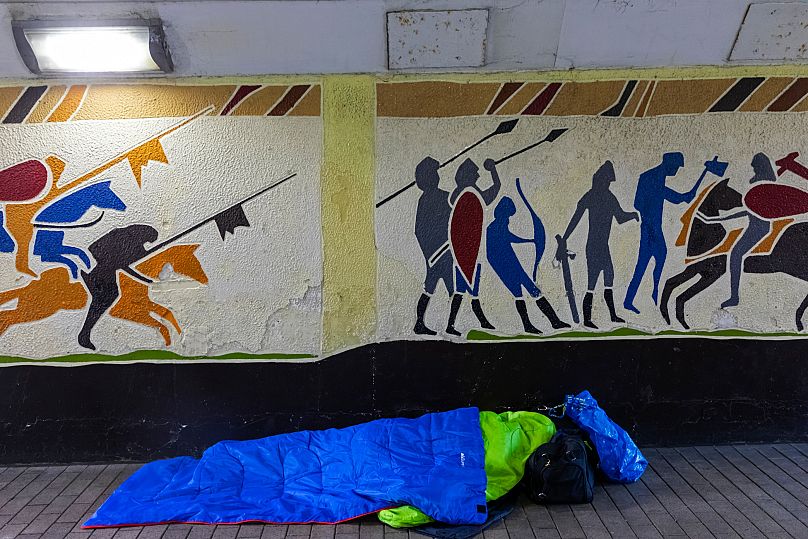In new data, it’s been revealed that overall spending on homelessness has increased by 10.5% since 2021/22 and a majority of councils have reported their costs have gone up.
Some 298,430 households in England became homeless or were at risk of becoming homeless, including 104,460 families with children between April 2022 and March this year.
That’s according to the latest government figures which also show the number of households in temporary accommodation was 104,510 - the highest on record.
The data, published by the Department for Levelling Up, Housing and Communities (DLUHC), also reveals that the number of people facing homelessness because they received a so-called ‘no-fault’ eviction notice increased by 27.4% to 24,260.
In the same period, there was also a 30.5% increase in people assessed by local authorities as sleeping rough.
In a strategy published last year, the Conservative government promised “bold commitments” to tackle rough sleeping as well as £2 billion (€2.29bn) of funding over the next three years.
It also said it would invest a further billion between 2022 and 2025 in the Homelessness Prevention Grant which is meant to fund local authorities to work with landlords to prevent evictions as well as offering financial support for people to find a new home and move out of temporary accommodation.
Many are now questioning whether or not the government has lived up to those promises.
In London alone, tackling the homelessness crisis is contributing to a staggering £500 million (€547m) shortfall in councils’ budgets.
The stark findings come alongside more figures released by the DLUHC, which shows that councils across England spent a record amount of money last year tackling homelessness.
At least £2.4bn (€2.75bn) was spent tackling the problem in 2022/23 and over £1.7bn (€1.95bn) of that amount was used to pay for temporary accommodation.
The worst affected areas were the North West and the North East. The city of Manchester has one of the highest levels of homelessness in all of England, with one local charity estimating 1 in 80 people there have no fixed address.
The biggest increase in homelessness since last year recorded by any council was Liverpool.
There, the cost of tackling homelessness increased by 341% in just one year.
The town of Warrington, located between Liverpool and Manchester, saw costs increase by 210% and the town of Darlington and the city of Wolverhampton saw their costs double.
In Hastings, a coastal town in the south east, the picture is particularly bleak, too.
Among a population of around 92,000, some 523 households are living in temporary accommodation - the majority forced to reside in places provided on a night-by-night basis by private providers.
Hundreds more are on a waiting list for urgent accommodation.
“In 2019 we were spending £730,000 (€838,000) on temporary accommodation. In 2022/23 we spent £4.5million (€5.2m), with a forecast of £5.6million (€6.4m) for 2023/24,” a spokesperson for the council tells Euronews.
Hastings’ council’s net budget was £22.9m (€26.2m) in 2010/11. That figure had fallen by 28% to £16.5m (€19m) during the 2022/3 period.
In 2010/11, direct government support - or grants - were at £15.9m (€18.2m) and down to just £1.5m (€1.7m) in 2022/23 - a reduction of more than 90%.
While the government says repeatedly that they are doing everything they can to alleviate the problem, many councils across England say they simply don’t have enough staff to manage the enormous caseload put upon them by the homelessness crisis.
The DLUHC has advised that a caseload of a maximum of 30 is needed to “enable officers to engage in prevention work” and has “expressed alarm at encountering caseloads of 75 elsewhere”, councils have reported officers forced to take on over 165 cases each.
Following the release of the figures, a number of charities across England have said that the latest figures showed there was an urgent need to increase housing benefits.
That’s a sentiment shared by the shadow minister for homelessness and building safety too.
Speaking at last week’s Labour Party Conference in Liverpool, MP Mike Amesbury explained that the definition of affordable housing should be changed to “make it relate to the income in people’s pockets and their household budgets”.
Amesbury told the audience that “the definition of affordable housing had been vandalised” by the Conservative government.
With the Labour party very much seen as the government-in-waiting, councils will be hoping their commitment to the growing homelessness crisis will be significantly more robust than the Conservatives’.












